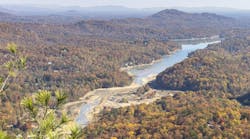One Challenge at a Time
Whether or not the condition of our nation’s water is generally improving or declining, it is clear that we have a long way to go toward reaching the Clean Water Act’s goal of eliminating non-point pollution discharges. Many storm water management programs have adopted benchmark treatment standards like 80% post-construction total suspended solids reduction to ensure that a basic level of protection is provided, but it is clear from the U.S. Environmental Protection Agency’s (EPA) latest National 303(d) List Fact Sheet that waters of the U.S. are being degraded by a wide variety of pollutants.
As new permits are issued incorporating total maximum daily load (TMDL) benchmarks, it is evident that a more rigorous approach to site design is required based on treatment of “pollutants of concern” to the “maximum extent practicable.” In California, this subjective language has been included in Phase I permits and storm water management plans through several renewal cycles. Currently, more than 40% of Phase I municipalities in California are operating under expired permits, due in part to the complex and litigious arguments over issues such as the feasibility of numeric effluent limits and program compliance measurement.
When issuing new permits, identifying likely pollutants of concern is the easy part. Tools like the California Stormwater Quality Association best managment practice (BMP) handbooks include a matrix of land uses and pollutants typically associated with them. There are nearly 25,000 completed TMDLs, and EPA publishes the 303(d) list of impaired waters every two years, giving specific causes of impairments. We can even model the increased flow rates and volumes associated with impervious surface development that must be addressed. The hard part is designing BMPs to mitigate all those pollutants of concern.
The most recent Section 303(d) List Fact Sheet inventories 2,656 completed TMDLs for sediment—accounting for nearly 11% of all TMDLs. Ahead of sediment on the list are pathogens, metals other than mercury and nutrients with a combined share of 54% of all TMDLs. Of all pollutants on the list, options for sediment removal are best understood. However, consider the added complexity of addressing other pollutants like pathogens, dissolved metals, nitrates and temperature. In this context, infiltrating BMPs seem to be the most viable approach so that the complicated technical challenges of treating these other pollutants can be avoided.
Unfortunately, many common site constraints limit the applicability of infiltration. Such cases require a rigorous analysis of unit processes active in various BMPs and design of a management system that includes the most efficient removal pathways for targeted pollutants. This approach requires a much more sophisticated understanding of the fundamental physical, chemical, biological and hydrologic processes that define BMP performance. It will take a concerted research effort to build this understanding in the engineering community so that we can confidently design effective site and pollutant-specific solutions. Completing this research and planning also will improve the accuracy of TMDL-compliant cost estimates. Then we can move on to what may be the most difficult challenge of all: building the political and financial capital to implement those management plans.
Download: Here

